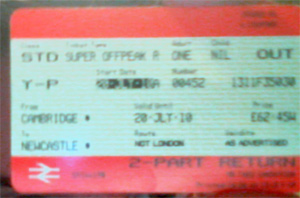Team:Cambridge/Notebook/Week2
From 2010.igem.org

Week 2
Monday
Did further research into the enzymes required for luciferase recovery.
- Presented proposals to advisors
- Modelled RNA to create aptazyme based system using trial of CLC RNA Workbench
- Made presentation for Newcastle
- Set up and tested low light camera
Tuesday
- 06.50 - Train to Newcastle for UK iGEM get-togther
Wednesday
Thursday
- 11am - Health and Safety talk by Barbara
- Working lunch at the Waffle Company. Summary of discussion:
- To do:
- Ordering
- Getting in touch with MIT (turning off lights)
- T-Shirts
- Project Plan (Gantt Chart etc)
- To do long-term:
- Modelling
- Firefly Bioluminescence
- Bacterial Bioluminescence
- Human Practices
- Quiescence
- Individual roles:
- Outline of experiments, protocols - Anja, Ben, Peter (especially controls)
- Modelling - Paul, Bill, Emily
- COSHH forms - Bill
- LRE biobrick - Theo
- Researching Bacterial Lux operon - Will, Hannah
- To do:
Friday
Meeting with Laura Rowe in the Biotechnology Dept. at 3pm:
- Brightness measurements are integrated over time, so when comparing them make sure they are integrated over a long time (otherwise you are only measuring how quickly luminescence occurs, not how bright).
- Different colours:
- Could use fluorophores instead of fluorescent proteins but need to ensure they attach to protein (could be a project in itself). Requires resonance energy transfer.
- Using mutant luciferases probably easier to implement.
- Expression in E. coli: inclusion bodies could be a problem when trying to over-express genes. To test: break open cells and centrifuge twice (at a higher speed second time around), if pellets are formed these are probably inclusion bodies. Could then dissolve these with solvent and test for bioluminescence from proteins within inclusion bodies.
- Relative light units are used because different camera properties, distances etc. all mean that photons/sec are relative. Can use a source for calibration - tritium standards are used (e.g. MGM instruments).
Paper from Duncan about mutant bacterial strain with very bright luminescence to be investigated further.
Saturday
Sunday
 "
"
